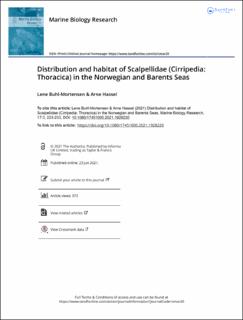Distribution and habitat of Scalpellidae (Cirripedia: Thoracica) in the Norwegian and Barents Seas
Peer reviewed, Journal article
Published version
Permanent lenke
https://hdl.handle.net/11250/2983363Utgivelsesdato
2021Metadata
Vis full innførselSamlinger
- Articles [3012]
- Publikasjoner fra CRIStin [3070]
Sammendrag
We describe the distribution and habitats of Amigdoscalpellum hispidum, Weltnerium stroemii, Scalpellum scalpellum, Weltnerium cornutum, Catherinum striolatum, Weltnerium nymphocola and Hamatoscalpellum hamatum in the Norwegian and Barents Seas, and their morphology. These are seven of the eight scalpellid species recorded in the area. Expeditions from 2006 to 2018 of the MAREANO (Marine areal database for Norwegian waters) programme have provided a comprehensive collection of Scalpellidae that can contribute to our knowledge of their distribution. The collections were from 335 localities in 40–2300 m depth. Of the 1406 specimens collected, 1396 were collected by beam trawl and 37 were from grabs. Patchy distributions and the association of species with other organisms (e.g. hydroids and gorgonian corals) can explain the low abundance in grabs compared with beam trawls, the latter covering larger areas and mixed sediments better. Weltnerium stroemii was the most abundant species and had the largest depth and temperature range, followed by A. hispidum and W. nymphocola. Species were assigned into three geographic groups based on their depth distribution. Shelf species: W. stroemii, S. scalpellum and A. hispidum occurring mainly shallower than 400 m in water temperatures >4°C; Upper slope species: W. nymphocola, W. cornutum and H. hamatum, found mainly between 600–1000 m in temperatures from 4 to 0°C; Lower slope species: C. striolatum occurring below 1500 m in temperatures <0°C. The species C. striolatum and W. cornutum are new to the Norwegian fauna and future deep-sea exploration will probably discover further scalpellid species.
